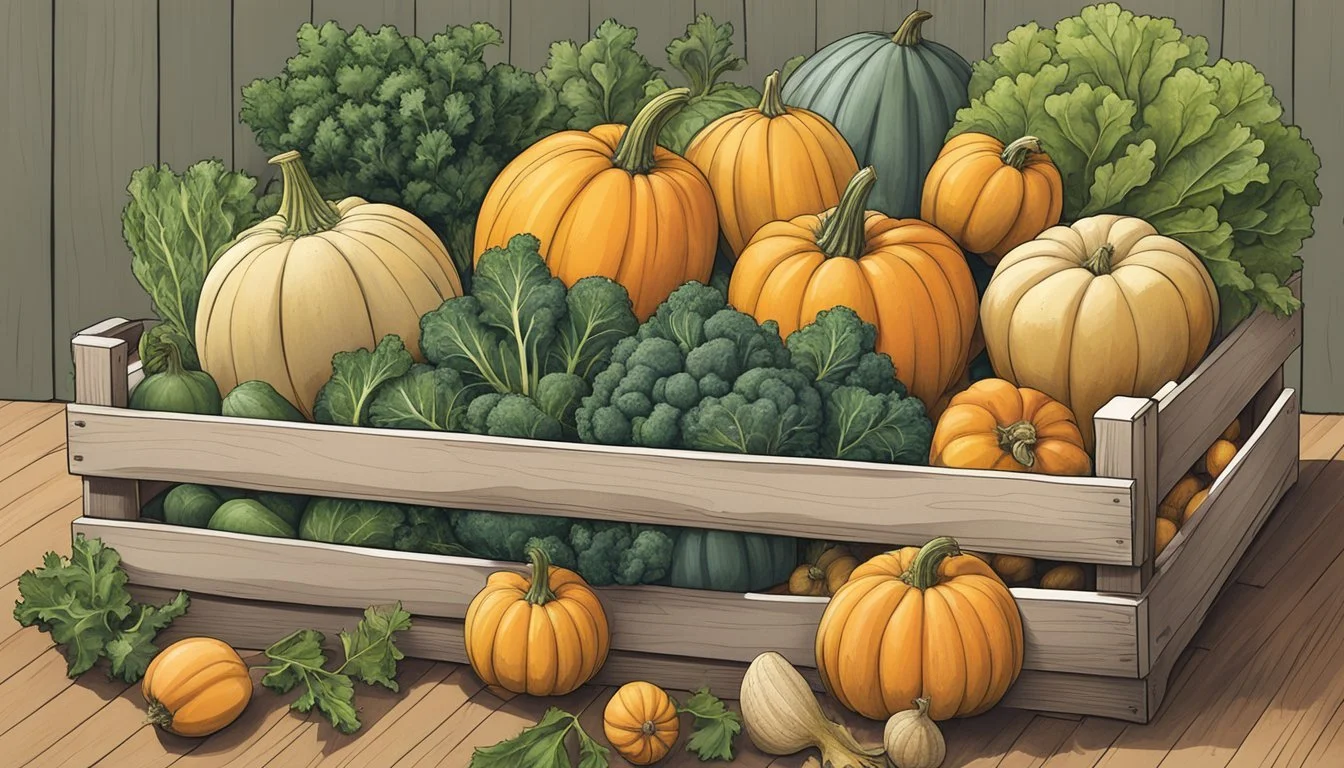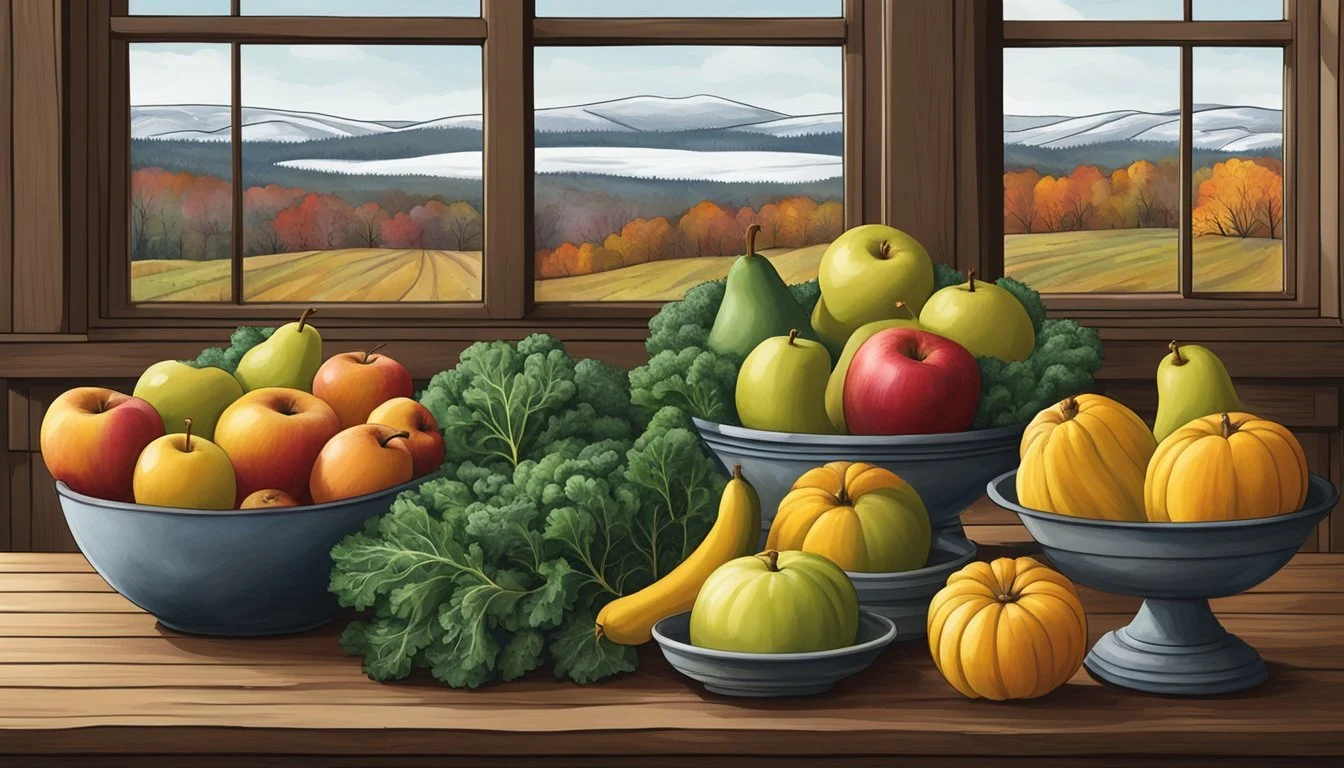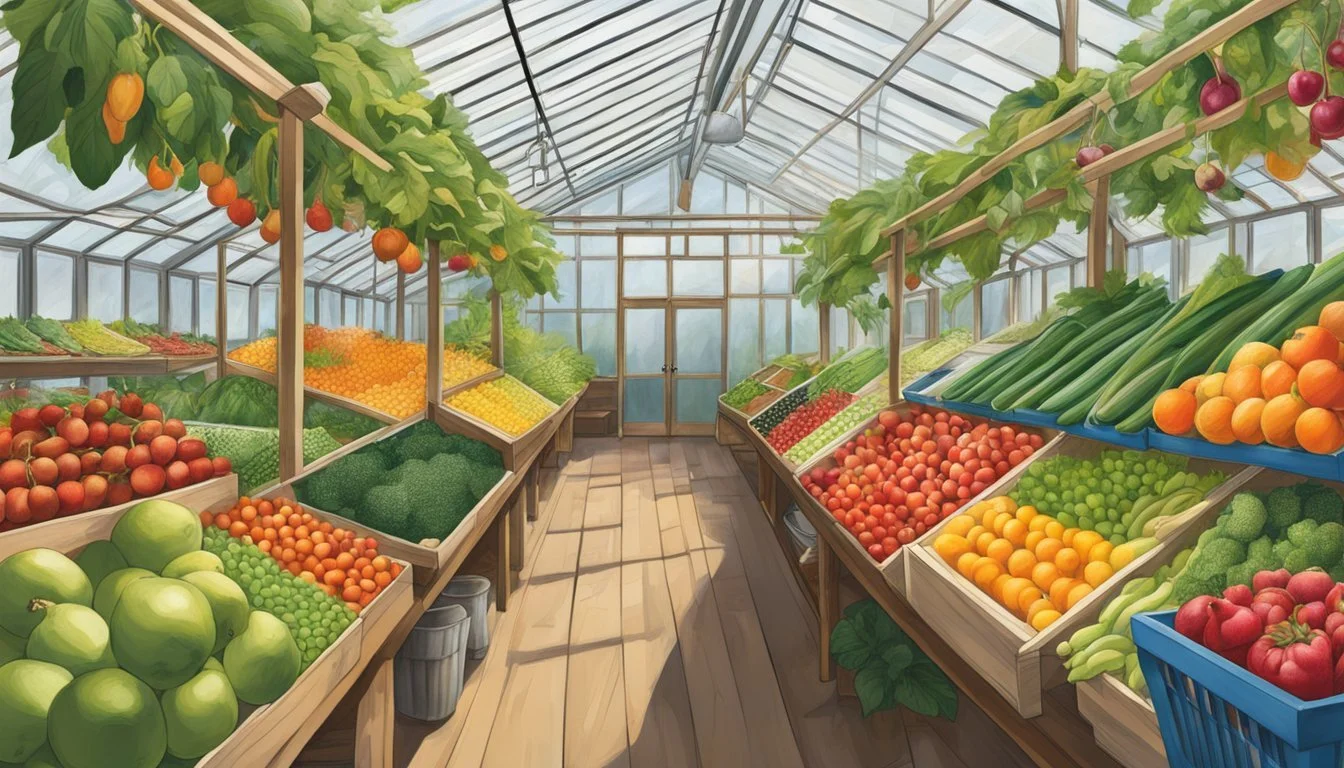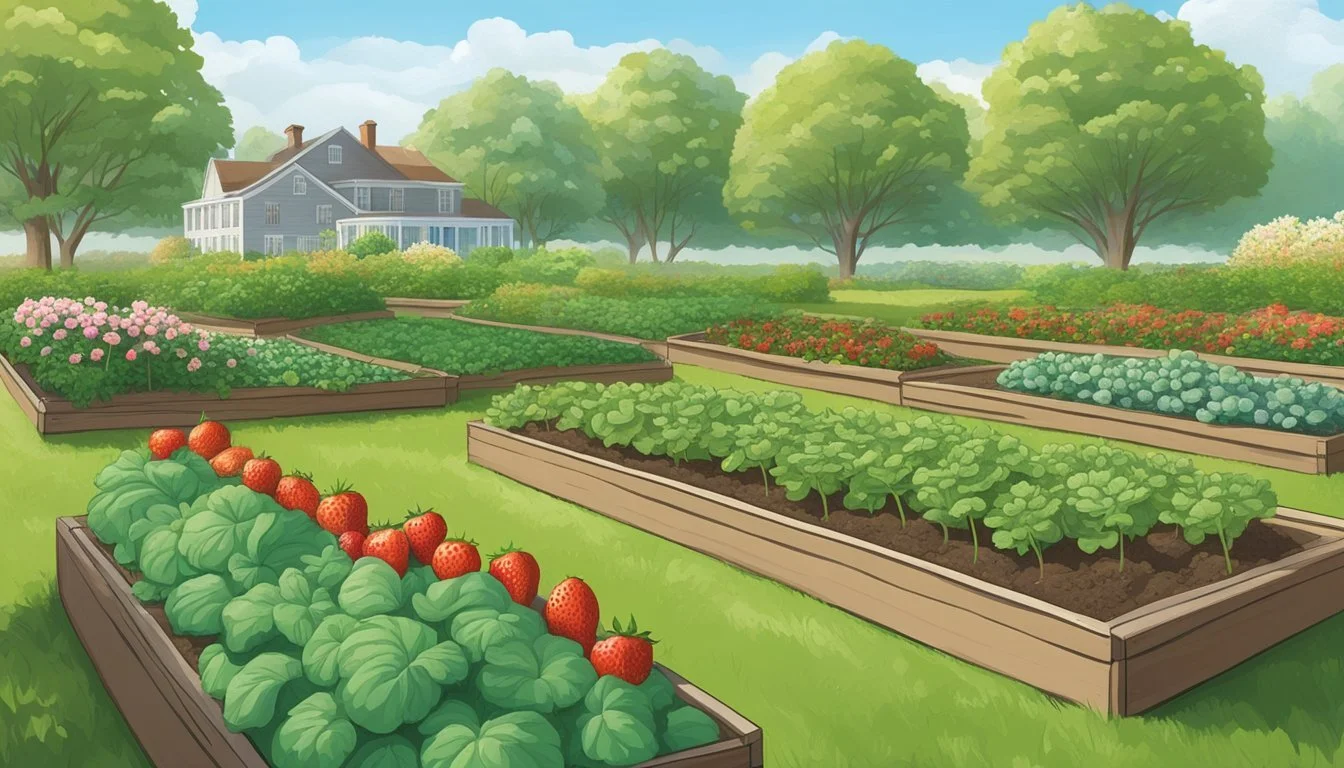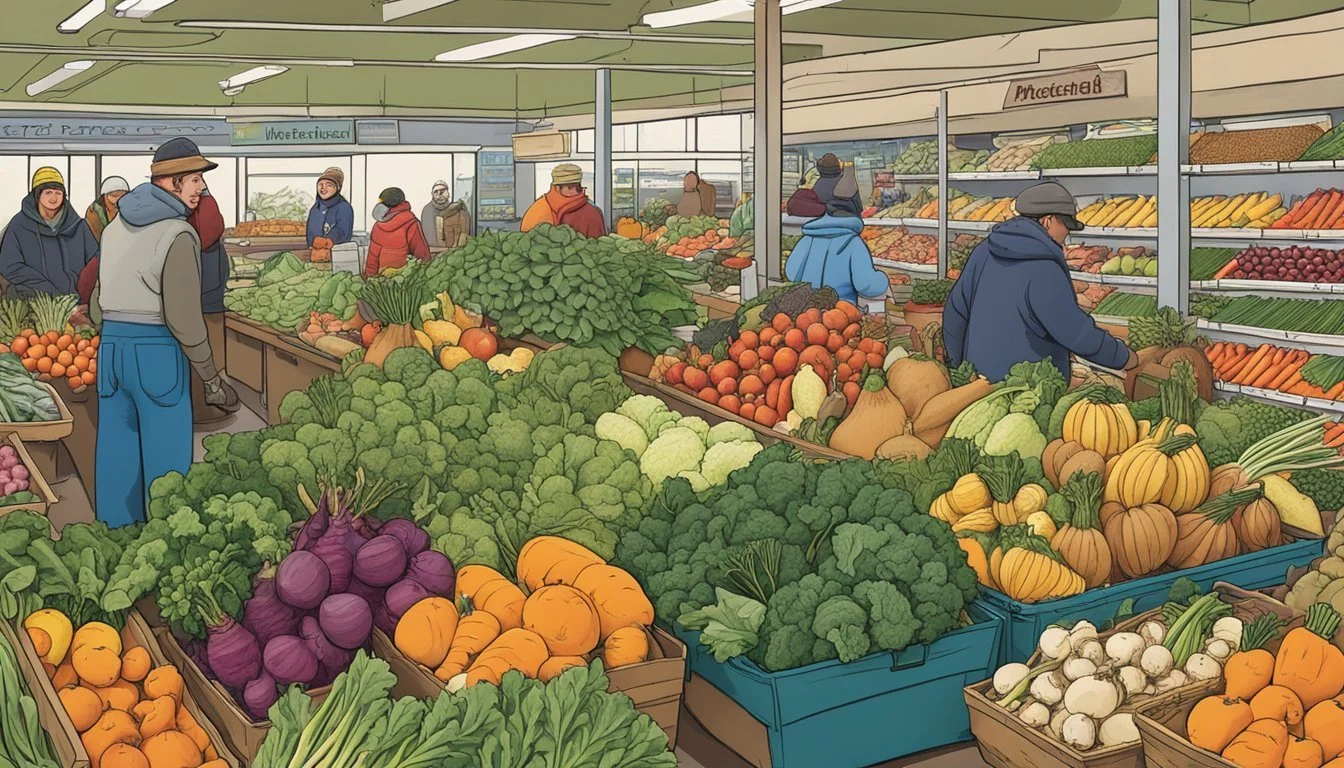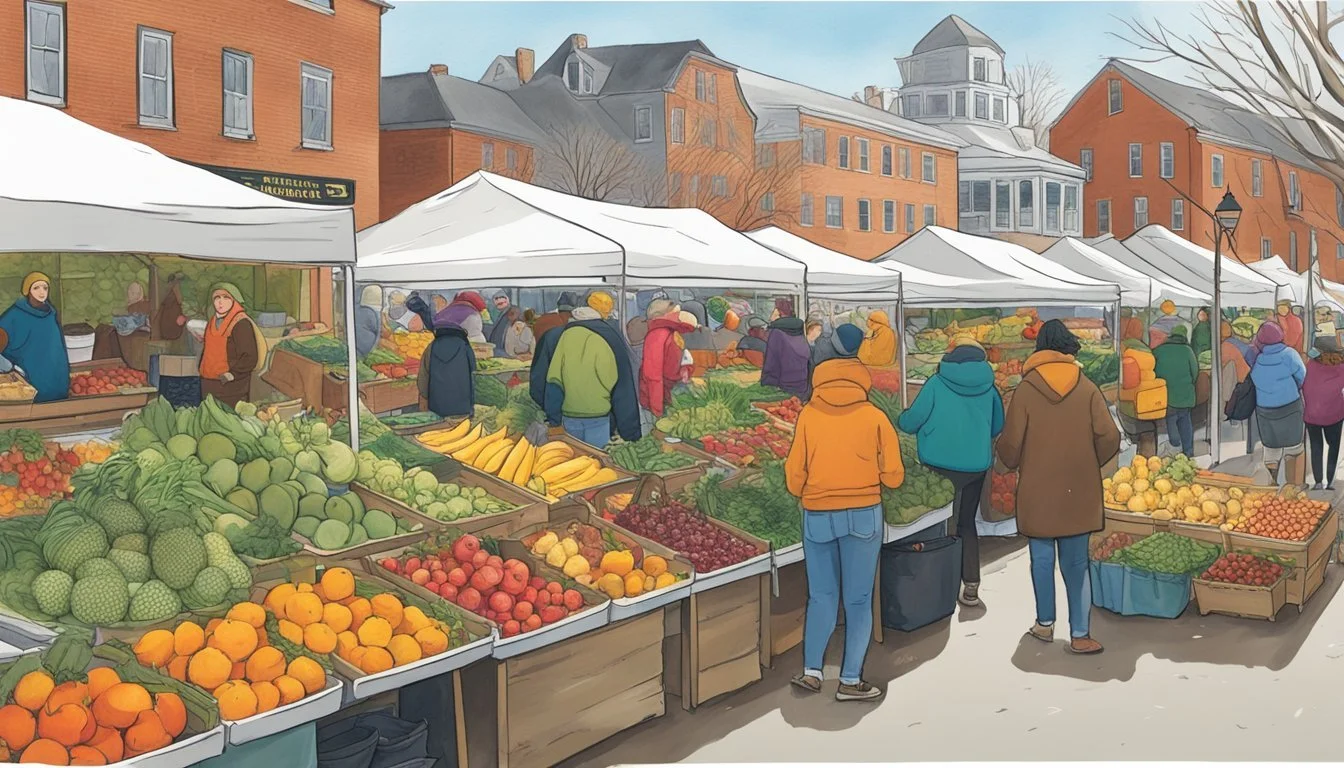Massachusetts Seasonal Fruit & Vegetables in January
A Shopper's Guide
This Article is Part of our Massachusetts Seasonal Fruit & Veg Calendar
Residents of Massachusetts seeking fresh, seasonal produce in January have a variety of options despite the chilly climate. During this month, hearty vegetables take center stage, providing both flavor and nutrition to sustain locals through the winter. These include robust options such as kale and other cruciferous vegetables like broccoli and Brussels sprouts. These greens are not only adaptable to cold weather but are also packed with essential vitamins and minerals, making them a staple for health-conscious consumers.
While fruit selections are more limited during this time due to the frosty temperatures, citrus fruits become a highlight in the winter diet. Bright oranges and grapefruits imported from warmer regions are often at their peak, bringing a burst of flavor and Vitamin C to the table, which is beneficial for immune support during flu season. Local root vegetables such as beets (how long do beets last?) are also available and offer a grounding component to meals, with their earthy sweetness and versatility in various recipes.
Farmers markets and local produce vendors continue to supply these seasonal items, ensuring that even in the heart of winter, Massachusetts residents have access to fresh, local produce. This commitment to seasonal eating not only supports the local economy but also encourages a sustainable relationship with food, influenced by the rhythms of the natural growing season.
Benefits of Eating Seasonally
Consuming fruits and vegetables in accordance with their natural growing seasons offers several advantages. Seasonal produce is typically fresher and possesses a higher nutritional value when compared to fruits and vegetables that are shipped over long distances.
For instance, vitamin C, a nutrient known for its antioxidant properties and roles in immune function, tends to be more abundant in fruits and vegetables that are picked at their peak ripeness. Seasonal consumption ensures that individuals get to enjoy produce that hasn't lost important nutrients like vitamin C and iron through long-term storage or transportation.
Eating seasonally also contributes to a more varied diet, often referred to as "tasty updates." Rotating foods based on seasonal availability introduces the palate to a diverse spectrum of flavors and textures, enhancing the culinary experience. This rotating menu not only keeps meals exciting but also encourages a wider intake of different nutrients.
Moreover, eating with the seasons aligns with environmental sustainability. It supports local farming, which tends to involve less transportation and, consequently, a reduced carbon footprint. It can also be more cost-effective, as seasonal produce is often more plentiful and, therefore, less expensive.
Table: Nutrient Comparison Based on Seasonality
Nutrient Seasonally Fresh Produce Off-Season Produce Vitamin C Higher Levels Reduced Levels Iron Optimal Content Possible Depletion
Embracing the bounty that each season offers can lead to a more balanced diet, contribute to environmental sustainability, and provide economic benefits to local farmers and consumers alike.
Winter Harvest: Vegetables in Season
In Massachusetts, January's cold climate limits the range of fresh produce. However, several resilient vegetables thrive during this season, offering rich nutrients and flavors.
Root Vegetables
Root vegetables are the underground powerhouses of winter, adept at storing energy and nutrients:
Turnips: High in vitamin C, turnips are a versatile staple, often harvested in January.
Carrots: Sweet and crunchy, carrots continue to be a cold-weather favorite.
Leafy Greens
Despite the frost, some leafy greens can survive and are harvested in winter:
Kale: A hardy vegetable that can withstand low temperatures.
Spinach: While not as frost-tolerant as kale, spinach can be grown in cold frames or hoop houses during the winter.
Arugula and Mizuna: These peppery greens can be found in winter markets, although their availability might be limited.
Cruciferous Vegetables
Cruciferous vegetables are well-suited to the cold and bring robust flavors to the winter table:
Broccoli: Often available until the first hard frost.
Cabbage: Stores well and remains available throughout winter.
Brussels Sprouts: They actually benefit from a touch of frost, which can sweeten their taste.
Alliums
Alliums are a foundational flavor for many dishes, and some are harvested even in the coldest months:
Onions: Stored from earlier harvests, they remain a kitchen staple.
Garlic: Typically planted in the fall and overwintered for a summer harvest, but stored garlic is available.
Leek: Hardy and capable of surviving the winter months, leeks can be harvested into January.
Winter Harvest: Fruits in Season
During the chilly days of January in Massachusetts, the fruit selection is more limited than in the bountiful summer months. However, individuals can still enjoy the crisp and hearty flavors that thrive in the winter climate.
Apples continue to be a staple of the winter fruit bounty. Storage varieties are often available, having been harvested in the fall and kept fresh for winter consumption. Varieties such as the Fuji, Gala, and Granny Smith are typically found in local markets this time of year.
Pears also make up a significant part of the winter fruit spectrum in Massachusetts. Although their season starts in the late summer, some varieties such as Bosc and Anjou pears are stored and enjoyed well into the winter months for their sweet and juicy characteristics.
Fruit enthusiasts can usually find these fruits:
Apples
Fuji
Gala
Granny Smith
Pears
Bosc
Anjou
Consumers should look for firmness and avoid any fruits with soft spots or blemishes to ensure they're getting the freshest produce available. It’s encouraged to buy from local sources when possible to support regional agriculture and ensure optimal freshness.
Indoor and Greenhouse Grown Produce
In Massachusetts during January, indoor and greenhouse farming plays a crucial role in supplying fresh produce. These controlled environments allow for the cultivation of select herbs and greens despite the outside cold.
Herbal Highlights
Indoor and greenhouse operations provide essential light and warmth, enabling the growth of herbs throughout January. The most commonly grown herbs include:
Basil (Ocimum basilicum)
Thyme (Thymus vulgaris)
Oregano (Origanum vulgare)
Parsley (Petroselinum crispum)
Farmers meticulously manage temperature and sunlight exposure either through artificial or natural means to maintain the delicate balance these plants require.
Year-Round Greens
Greenhouse gardens also assure a steady supply of greens. Access to these produces is typically available at local farmers markets, despite the harsh outdoor environment. Key greens include:
Lettuce - known for its versatility and multiple varieties.
Peppers - although more demanding, some greenhouse farmers still manage to yield a healthy crop.
The produce from these indoor setups offer freshness and quality akin to those grown in traditional outdoor gardens during favorable seasons.
Planning the Spring Garden
As January unfolds in Massachusetts, gardeners begin preparations for their spring garden—an exciting venture. They scrutinize weather patterns, consider frost dates, and prepare their schedules for late February and early March, which are pivotal times for starting transplants indoors. A gardener's plan largely hinges upon the understanding that certain crops can be started inside during these winter months to ensure a hearty spring planting.
One must not overlook the importance of choosing the right flowers and vegetables for transplanting. Comprehensive knowledge of regional frost dates guides gardeners on the perfect timing for moving young plants outside. It's essential to discern which plants thrive in the unpredictable Massachusetts springtime.
Here is a brief guide to starting your spring garden:
Vegetables to Start Indoors in Late February to Early March:
Tomatoes
Peppers
Broccoli
Flowers to Start Indoors:
Marigolds
Petunias
Zinnias
A gardener in Massachusetts schedules the transplanting of these seedlings to the garden after the last frost, typically towards late spring. Preparing the garden soil early by testing and amending it ensures a suitable environment for the transplants.
When meticulously planning their spring garden, successful gardeners in Massachusetts remain heedful of the local climate nuances. They create a well-timed roadmap for their garden, which often yields a bountiful harvest, colorful blooms, and a sense of fulfillment as they watch their careful planning come to fruition.
Monthly Harvest Calendar
In Massachusetts, January's cold climate means most fresh produce is in limited supply. However, storage crops from previous seasons and some greenhouse-grown items are still available.
Late January Offerings
In late January, one finds a limited but focused selection of fresh produce. Root vegetables and hardy winter greens stand out in the limited January harvest. They might find:
Root Vegetables: Storage crops like carrots and turnips are still on offer.
Apples: Stored from the fall harvest, various apple varieties are available.
Greens: Items such as kale and collards may be accessible, often grown in protected environments like greenhouses.
Seasonal Shifts in Early February
As Massachusetts transitions into early February, they observe slight variances in available produce due to indoor farming and the approach of spring. For instance:
Greenhouse Produce: Some farms provide greenhouse-grown vegetables such as lettuces and herbs which became more prominent at farm stands.
Root Vegetables: Potatoes and beets, from storage, continue to be mainstays of the local diet.
Local Farming and Produce Availability
In January, Massachusetts faces the chilly embrace of winter, which significantly impacts local farming and the produce available. Farmers market offerings - although more limited compared to the summer months - persist in showcasing hardy root vegetables and storage crops. Staple items such as potatoes, carrots, and beets typically endure the cold, making them reliable choices for consumers seeking fresh, local produce.
Indoor markets or winterized sections of year-round markets provide residents with continued access to local goods. Here, farmers and vendors adapt to the colder climate by offering cold storage fruits like apples and a variety of winter squashes that have a long shelf life post-harvest.
Vegetables:
Potatoes
Carrots
Beets
Winter squash
Onions
Fruits:
Apples
Regional variations in produce availability do occur, influenced by microclimates within the state. While January in New York may offer a slightly different range of produce due to its size and varied geography, Massachusetts maintains a modest but quality selection focused on root and storage crops.
Local farming efforts push on despite January's frost, though output is naturally reduced. These farms often implement season extension techniques, such as greenhouse growing, to provide greens like kale and hearty herbs. Community-supported agriculture (CSA) programs also continue to distribute these offerings to invested locals.
Overall, January's local produce in Massachusetts is reflective of a region well-adapted to its seasonal cycles, offering a selection that although reduced, remains diverse enough to support local consumption and nutritional needs.
Health and Nutrition
In Massachusetts during January, consuming seasonal produce such as kale and spinach contributes significantly to health and wellness through the intake of essential vitamins and minerals. These greens are not only hearty but packed with nutrition that benefits the body during the colder months.
Vitamins and Minerals
Vitamin C: Citrus fruits, which are in season, are excellent sources of Vitamin C, crucial for boosting the immune system.
Iron: Greens like kale and spinach are rich in iron, necessary for oxygen transport in the body and the prevention of anemia.
These vegetables are staples in a nutrient-dense diet and, when consumed regularly, support overall physical health.
Dietary Considerations
When incorporating seasonal fruits and vegetables into one's diet, it is important to consider their compatibility with specific dietary needs:
Gluten-free: Kale and spinach are naturally gluten-free, making them suitable for those with celiac disease or gluten sensitivity.
Vegan: Both greens are also vegan and contribute to a plant-based diet's requirements for iron and Vitamin C.
Recipes and Preparation Tips
In January, Massachusetts offers a limited but delightful range of local produce. Cooking with seasonal vegetables such as kale, leeks, and beets can bring vibrant flavors and nutrition to the winter table.
Kale, a hearty green, is splendid in salads or sautéed. They recommend massaging kale with a bit of olive oil and salt to tenderize it for raw dishes. For cooking, one tip is to pair kale with garlic and a dash of red pepper flakes (how long do red pepper flakes last?) for added warmth and depth.
Leeks, another winter staple, can be used to infuse subtle, onion-like flavor into soups and stews. Chefs suggest slicing leeks thinly and rinsing them well to remove any grit before sautéeing to coax out their sweetness.
For beets, roasting is a standout method that enhances their earthy sweetness. Cooks should wrap beets in foil and roast until tender, after which they easily peel and can be added to salads, like a beet and goat cheese salad, or served as a side dish with balsamic glaze.
Citrus fruits, which are also in season, brighten up dishes with their zesty flavors. They can squeeze orange or lemon juice over roasted vegetables for a refreshing twist, or incorporate them into vinaigrettes.
For those seeking tasty updates to their recipe repertoire, subscribing to culinary newsletters or following food blogs can be a great source of seasonal inspiration.
Ingredient Cooking Tip Kale Massage for salads; sauté with garlic for warmth Leeks Slice thinly, rinse well, and sautée to bring out sweetness Beets Roast in foil; serve in salads or with balsamic glaze Citrus Use juice to brighten dishes; add to dressings
Avid cooks and novices alike can enjoy the seasonal bounty with these simple preparation tips, ensuring meals are not only delicious but also aligned with what nature provides during the winter in Massachusetts.
Community and Events
January in Massachusetts is a time when the local communities come together to celebrate the offerings of the season, despite the cooler temperatures. Farmers' markets throughout the state provide a warm and inviting atmosphere to find the freshest local produce and tasty updates from the region's growers.
Winter Farmers' Markets: They operate with scaled-back frequency but offer hearty winter vegetables and seasonal delights. Market-goers can expect to find root vegetables like carrots and beets, alongside cold-hardy greens.
Events to Look For:
Cooking Demonstrations: Seasonal cooking classes using January's bounty may be available.
Meet the Farmers: An opportunity for consumers to learn about eating with the seasons directly from the source.
The markets often host live music, workshops, and other community-oriented events that make shopping for groceries an enjoyable experience. They not only support local agriculture but also serve as a venue for education on seasonal eating.
Event Type Description Benefits Cooking Classes Utilize seasonal crops Learn recipes & cooking tips Meet Your Farmer Discussions with growers Understand farming practices
Embracing local, seasonal eating aligns with sustainable practices and enriches the community's connection to its food sources. Moreover, the expenditure at these markets bolsters the local economy and sustains the agricultural community, maintaining a thriving food scene in Massachusetts.
Storing and Preserving
When it comes to preserving the freshness and extending the shelf life of produce, Massachusetts residents can employ a variety of storage methods through the winter months. Temperature control and environment are crucial factors in preventing spoilage and maintaining nutritional value.
Refrigeration
For most vegetables, maintaining a consistent refrigeration temperature can dramatically extend shelf life. Refrigerators should be set at or below 40°F (4°C). Here's a quick list for refrigerated storage:
Leafy Greens: Store in plastic bags with paper towels to absorb excess moisture.
Root Vegetables: Keep in a crisper drawer to retain moisture and firmness.
Freezing
Produce can be preserved longer through freezing, which is ideal for fruits and vegetables that are in peak condition. Users should ensure their freezer is at 0°F (-18°C) or lower for optimal preservation. Vegetables should be blanched before freezing to preserve color, flavor, and texture.
Dry and Cool Storage
Some vegetables prefer dry and cool conditions, ranging from 50-60°F (10-15°C). The following can be stored under such conditions:
Potatoes: Store in a dark, well-ventilated space to prevent sprouting.
Onions: Keep in mesh bags away from light to avoid moisture accumulation.
Canning
Canning is another method for preserving that can be suitable for a variety of fruits and vegetables. It requires sterile containers and proper sealing techniques to prevent bacterial growth.
AuthProvider, residents can use these methods to preserve Massachusetts' seasonal bounties even during the winter's off-season months.
Supporting Local Agriculture
In Massachusetts, January is a time to support local agriculture by engaging with various community initiatives. Patrons can subscribe to Community Supported Agriculture (CSA) programs, which provide a stable income for farmers during the slower winter months. By paying up-front for a season's worth of produce, subscribers invest directly in the livelihood of local growers and the local economy.
Farmers markets remain a hub for seasonal offerings even in January, showcasing storage apples, root vegetables, and various greenhouse-grown produce—items that reflect the region's capacity for year-round farming. Participation in these markets stimulates the local economy by keeping money within community bounds and supporting farm families.
Here's a succinct overview of how individuals can contribute:
Subscribe: Joining a CSA entails receiving a regular allotment of farm produce, which can sometimes include winter-grown vegetables or preserved goods.
Visit: Regular visits to local farmers markets ensure consistent support for producers, encouraging the continuance of diverse, fresh offerings.
Educate: Learn about the seasonal produce calendar to appreciate the value and availability of local products during different times of the year.
By engaging in these actions, consumers play an active role in sustaining agriculture in Massachusetts. Moreover, they help foster a robust relationship between grower and consumer, reinforcing community bonds and ensuring the continuation of local farm traditions.
Environmental Impact
Purchasing seasonal fruits and vegetables in Massachusetts during January can lead to more sustainable choices. During this month, local produce is limited due to the cold climate. However, when consumers opt for locally grown, available produce, transport-related carbon emissions are significantly reduced compared to purchasing out-of-season produce that has been shipped from warmer regions or countries.
Seasonal foods also tend to have a lower environmental footprint. The production of out-of-season produce often involves additional energy for heating in greenhouses, refrigeration during storage, and transportation over long distances. By choosing local produce that naturally grows in the winter months, consumers indirectly discourage these resource-intensive practices.
Moreover, eating seasonally ensures a diverse rotation of crops which is beneficial for soil health and biodiversity. Farmers growing for a local, seasonal market typically use more sustainable farming methods, which include crop rotation and organic practices to maintain soil fertility.
Local produce in January may include storage crops such as:
Root vegetables: carrots, turnips
Squashes: butternut, acorn
Leafy greens: kale, collards
By making informed decisions to consume seasonally and locally, individuals can contribute to a lower collective environmental impact while supporting the region's agricultural community.
Conclusion
Massachusetts residents enjoy a variety of produce year-round, but the selection in January tends to be limited due to the cold New England winter. During this time, storage crops and hardy vegetables are more common than fresh, delicate fruits.
Vegetables: Consumers can typically find root vegetables such as horseradish, which has a pungent flavor and is often used as a condiment. It is in season and provides a burst of flavor to winter dishes.
Fruits are scarce locally during this month, so Massachusetts largely relies on storage or imports for fruit.
Eating with the seasons in January emphasizes the importance of adapting culinary practices to available produce. It encourages a diet revolving around hearty vegetables that withstand cold temperatures.
Residents can look forward to a wider variety of fresh produce as the seasons progress into spring and summer, when items like berries and summer squash become plentiful. For now, they make the most of the winter offerings, utilizing them in innovative, warming dishes that suit the season's atmosphere.

